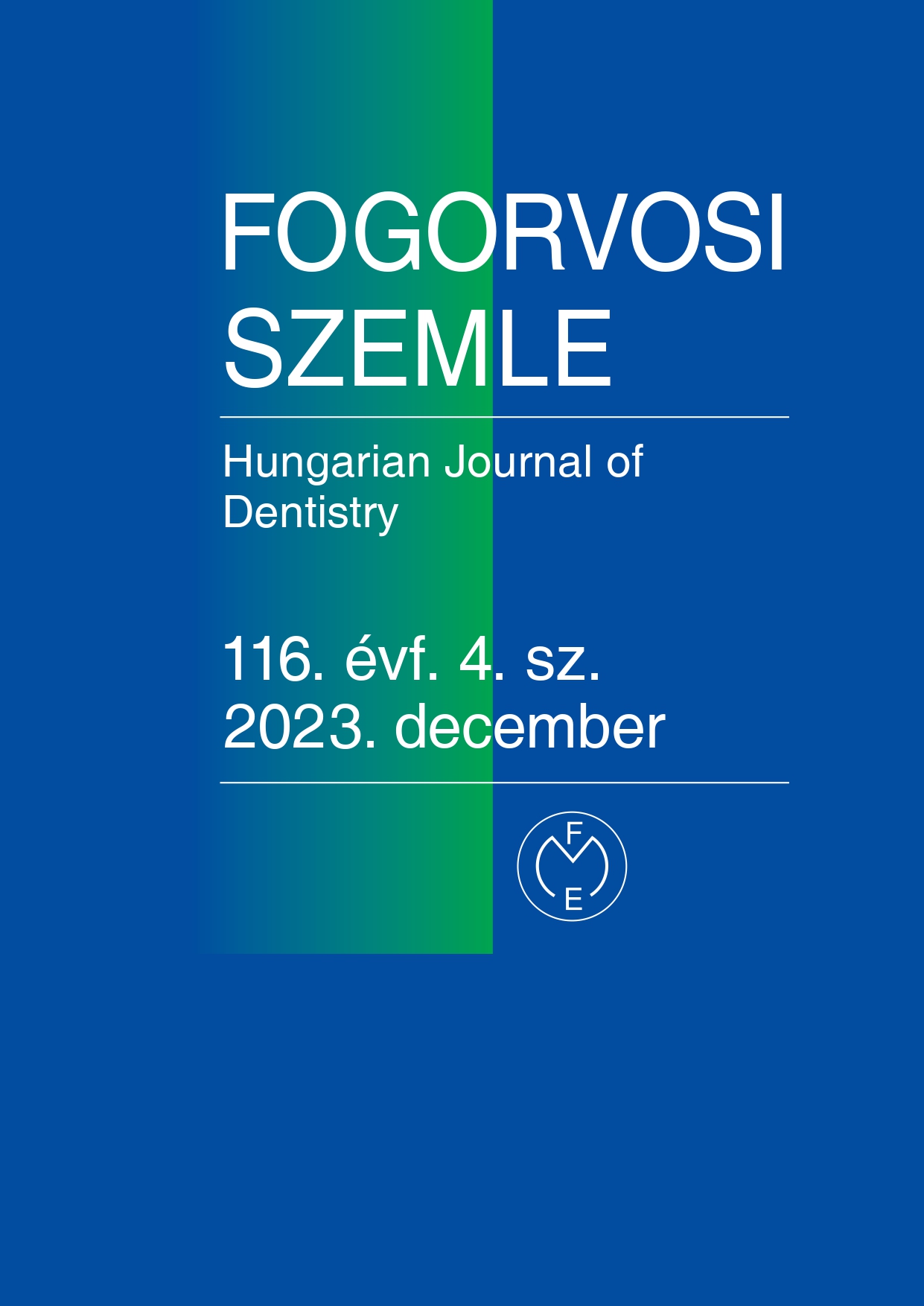Prosthetic rehabilitation of a young patient with dentinogenesis imperfecta and hemophilia A
Abstract
Introduction: Dentinogenesis imperfecta (DI) is a genetic disease that affects the dentin of the teeth. The autosomal
dominantly inherited disease affects only the tissues of connective tissue (mesodermal) origin of the teeth, so there are
no changes in the enamel and the periodontium. Due to poor quality dentin, the teeth become discolored and the enamel
easily peels off. In the dental treatment of patients with DI, the focus should be on indirect restorations as soon as possible,
so the dentist must diagnose the condition as early as possible so that the possibility of early intervention is realized,
as well as balancing the decision for early intervention with the long-term survival of the restorations.
Case report: A 15-year-old young male patient came to the Department of Paediatric Dentistry and Orthodontics of
Semmelweis University, to have the veneers on his lower incisors replaced. He also wanted a comprehensive aesthetic rehabilitation.
The anamnesis revealed that the patient’s father also suffers from DI, and the patient lives with hemophilia A.
Based and the literature evidence and recommendations, we planned indirect restorations. The decreased occlusal vertical
dimension was increased; in the first phase to adapt the neuromuscular system to the increased vertical dimension,
polymethyl-methacrylate (PMMA) restorations were prepared. After the patient both aesthetically and functionally having
been satisfied with the temporary restorations, the final restoration were planned as a monolithic zirconia crowns and
splints for the upper and lower arches. For the cementation resin modified glass ionomer was used to avoid the adhesive
technique, which is not recommended in such cases. The prosthodontic phase was preceded by professional oral
hygiene treatment, instruction, and motivation.
Summary: For patients with DI, the key is the early diagnosis and its treatment is essential. Scientific evidence indicates
that indirect restorations should be preferred over direct ones in patients with DI. Close cooperation with the hematologist
is necessary during the treatment of the patient with hemophilia A.
References
de La Dure-Molla M, Philippe Fournier B, Berdal A: Isolated dentinogenesis imperfecta and dentin dysplasia: revision of the classification. Eur J Hum Genet 2015; 23 (4): 445–451. https://doi.org/10.1038/ejhg.2014.159
Schulte JM, Waes Hv: Dentinogenesis imperfecta. Medizinische Genetik 2007; 19 (4): 418–421. https://doi.org/doi:10.1007/s11825-007-0048-9
Martín-Vacas A, de Nova MJ, Sagastizabal B, García-Barbero ÁE, Vera-González V: Morphological Study of Dental Structure in Dentinogenesis Imperfecta Type I with Scanning Electron Microscopy. Healthcare (Basel) 2022; 10 (8). https://doi.org/10.3390/healthcare10081453
Shields ED , Bixler D, el-Kafrawy AM: A proposed classification for heritable human dentine defects with a description of a new entity. Arch Oral Biol 1973; 18 (4): 543–553. https://doi.org/10.1016/0003-9969(73)90075-7
Delgado AC, Ruiz M, Alarcón JA, González E: Dentinogenesis imperfecta: the importance of early treatment. Quintessence Int 2008; 39 (3): 257–263.
MacDougall M, Jeff ords LG, Gu TT , Knight CB, Frei G, Reus BE, et al: Genetic linkage of the dentinogenesis imperfecta type III locus to chromosome 4q. J Dent Res 1999; 78 (6): 1277–1282. https://doi.org/10.1177/00220345990780061301
Thotakura SR, Mah T, Srinivasan R, Takagi Y, Veis A, George A: The non-collagenous dentin matrix proteins are involved in dentinogenesis imperfecta type II (DGI-II). J Dent Res 2000; 79 (3): 835–839. https://doi.org/10.1177/00220345000790030901
Dhaliwal H, McKaig S: Dentinogenesis imperfecta–clinical presentation and management. Dent Update 2010; 37 (6): 9–71, 364–366. https://doi.org/10.12968/denu.2010.37.6.364
Agel M, Alani A: The paediatric dentistry-restorative dentistry interface. Br Dent J 2022; 233 (6): 475–482. https://doi.org/10.1038/s41415-022-4983-2
Fan F, Li N, Huang S, Ma J: A multidisciplinary approach to the functional and esthetic rehabilitation of dentinogenesis imperfecta type II: A clinical report. J Prosthet Dent 2019; 122 (2): 95–103. https://doi.org/10.1016/j.prosdent.2018.10.028
Bhandari S, Pannu K: Dentinogenesis imperfecta: a review and case report of a family over four generations. Indian J Dent Res 2008; 19 (4): 357–361. https://doi.org/10.4103/0970-9290.44543
Tordai A: Hematológiai és immunológiai betegségek örökletes tényezőinek vizsgálata: Országos Gyógyintézeti Központ; 2005.
Shastry SP, Kaul R, Baroudi K, Umar D. Hemophilia A: Dental considerations and management. J Int Soc Prev Community Dent 2014; 4 (Suppl 3): S147–152.https://doi.org/10.4103/2231-0762.14902214. Ayyildiz S, Sahin C, Akgün OM, Basak F:
Combined treatment with laser sintering and zirconium: a case report of dentinogenesis imperfecta. Case Rep Dent 2013; 2013:745959. https://doi.org/10.1155/2013/745959
Alrashdi M, Schoener J, Contreras CI, Chen S: Full Mouth Rehabilitation of Two Siblings with Dentinogenesis Imperfecta Type II Using Different Treatment Modalities. Int J Environ Res Public Health 2020; 17 (19). https://doi.org/10.3390/ijerph17197029
Soliman S, Meyer-Marcotty P, Hahn B, Halbleib K, Krastl G: Treatment of an Adolescent Patient with Dentinogenesis Imperfecta Using Indirect Composite Restorations – A Case Report and Literature Review. J Adhes Dent 2018; 20 (4): 345–354. https://doi.org/10.3290/j.jad.a40991
Copyright (c) 2023 Authors

This work is licensed under a Creative Commons Attribution 4.0 International License.


.png)




1.png)



